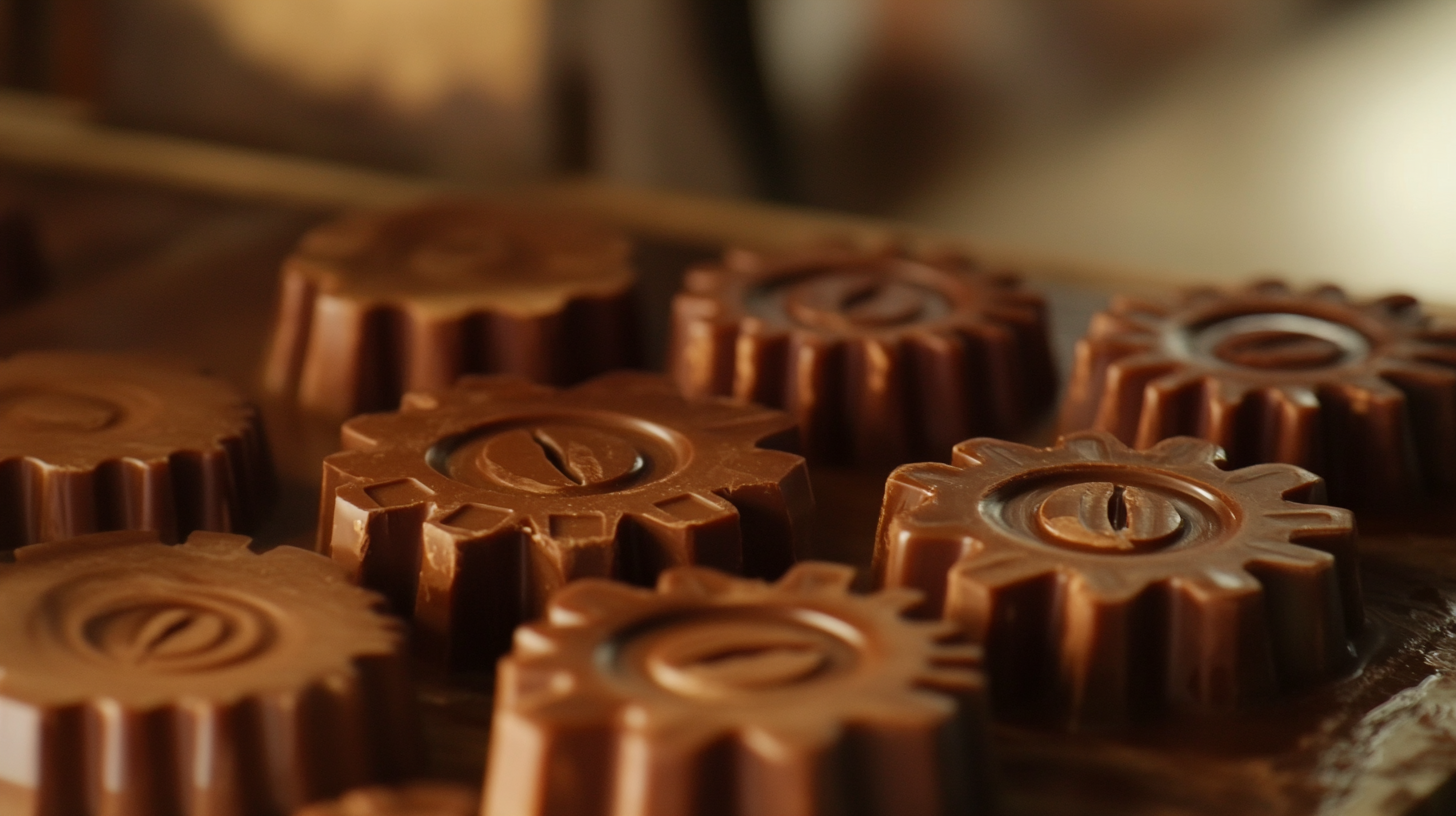5 Essential Tips for Choosing the Perfect Chocolate Molding Machine
In the ever-evolving world of chocolate production, the significance of a high-quality chocolate molding machine cannot be overstated. According to a recent report by the Research and Markets, the global chocolate market is projected to reach USD 162.5 billion by 2024, with a substantial portion of this growth attributed to innovative manufacturing technologies. As businesses seek to keep pace with rising consumer demands for diverse and high-quality chocolate products, investing in the right chocolate molding machine becomes essential. The proper equipment ensures not only efficiency in production but also enhances the overall quality of the confections produced.
Moreover, the chocolate molding process plays a crucial role in determining the final product's aesthetics and taste. As highlighted by the International Cocoa Organization, chocolate molding technology has advanced significantly, enabling manufacturers to achieve intricate designs and textures that appeal to the modern consumer. To capitalize on these opportunities, manufacturers must carefully evaluate their options, understanding the various features and functionalities offered by different chocolate molding machines. This guide aims to provide five essential tips to help you choose the perfect chocolate molding machine tailored to your specific production needs and market goals.

Understanding Different Types of Chocolate Molding Machines
When it comes to chocolate production, selecting the right molding machine is crucial for achieving high-quality results. Chocolate molding machines can generally be categorized into a few distinct types, each suited to different production needs and scales. These include manual, semi-automatic, and fully automatic machines, and understanding their differences can significantly impact your business.
Manual chocolate molding machines are ideal for small-scale operations or artisanal chocolatiers who prioritize craftsmanship over volume. These machines require more hands-on involvement, allowing for greater control over the molding process and customization of designs. However, the labor-intensive nature of manual machines means they are best suited for low to moderate production levels.
On the other hand, semi-automatic and fully automatic machines cater to larger production requirements. Semi-automatic machines offer a blend of manual and automated features, allowing operators to control certain aspects while streamlining the process for higher efficiency. Fully automatic machines, meanwhile, handle everything from melting the chocolate to filling the molds with minimal human intervention. They are perfect for high-volume operations, enabling businesses to scale up production without compromising on quality.
By understanding these different types of chocolate molding machines, you can make an informed choice that aligns with your production goals and business model. Whether you’re an artisan chocolatier or a large manufacturer, selecting the right machine is a pivotal step toward delivering exceptional chocolate products to your customers.
Key Features to Look for in a Chocolate Molding Machine
When selecting the perfect chocolate molding machine, it's essential to understand the key features that contribute to the efficiency and quality of chocolate production. First and foremost, consider the machine's temperature control capabilities. Proper tempering is crucial for achieving glossy finishes and a satisfying snap in chocolate products. Machines that offer precise temperature regulation can greatly enhance the molding process, ensuring consistency and quality in each batch.
Another vital feature to look for is the machine's capacity. Depending on your production needs, you might require a device capable of handling large volumes. Modern chocolate molding machines are designed to meet the demands of both artisanal chocolatiers and larger manufacturers, accommodating a wide range of output levels without sacrificing quality. Furthermore, advancements in technology have led to hybrid and modular designs that improve efficiency and adaptability, allowing for seamless transitions between different chocolate types and molds.
Lastly, consider user-friendly interfaces and automation options. With many chocolate makers emphasizing fresh and high-quality products, like those seen in long-standing establishments, having a machine that simplifies operation and maintenance can significantly save time and reduce labor costs. Innovations in chocolate production equipment, such as those for aerated and enrobed chocolate, highlight the ever-evolving landscape of confectionery technology, making these features crucial for any serious chocolate producer aiming for market competitiveness.
Assessing Production Capacity and Efficiency Requirements
When selecting a chocolate molding machine, assessing production capacity and efficiency requirements is crucial for ensuring that your investment aligns with your business goals. First, you need to evaluate the scale of your operations. Are you a small artisan chocolatier looking to produce specialty items, or a large manufacturer aiming for mass production? This distinction will influence the machine's output capacity. Choose a machine that not only meets your current production needs but can also be scaled up as your business grows.
Next, consider the efficiency of the molding machine in relation to your production process. Look for machines that integrate advanced technologies such as automated feeding systems and precision temperature controls. These features can significantly enhance production efficiency by minimizing waste and maintaining consistent quality. Additionally, review the machine’s cycle time—how quickly it can mold and set chocolate—since faster turnaround times can lead to higher output and profitability.
Lastly, performance metrics such as energy consumption and maintenance needs should be analyzed. An energy-efficient model may have a higher upfront cost but will lead to savings in operating costs over time. Regular maintenance requirements can also affect your production schedule, so opt for a machine with easy access for servicing and support. By thoroughly assessing these factors, you can choose a chocolate molding machine that not only meets your production capacity but also maximizes efficiency in your chocolate-making process.
Budgeting for Quality: Cost Considerations in Molding Machines
When selecting the perfect chocolate molding machine, budgeting for quality is a critical consideration. The cost of such machinery can vary significantly based on features, capabilities, and technology. It’s essential to understand the specific needs of your production line before making an investment. According to industry reports, a high-quality chocolate molding machine can range from $20,000 to $100,000, depending on its capacity and automation level.
In recent evaluations of manufacturing technologies, the impact of machine learning on cost efficiency has been substantial. For instance, companies investing in advanced machinery, like two-shot molding machines, have noted cost savings linked to producing completed products every cycle. Such efficiencies are paramount in the chocolate industry, where time and consistency directly affect product quality and profitability. Data suggests that the overall operational savings can be as high as 30% in scenarios where advanced technologies are utilized.
Additionally, maintenance costs should not be overlooked. A well-maintained machine guarantees optimal performance, reducing waste and downtime. Industry studies indicate that yearly maintenance can represent about 10-15% of the initial purchase price, making it another factor to consider in your overall budget. By factoring in these elements into your decision-making process, you can ensure that your investment in a chocolate molding machine not only meets your current needs but also prepares your business for future growth and efficiency in production.

Maintenance and Support: Ensuring Longevity of Your Equipment
When it comes to selecting the perfect chocolate molding machine, maintenance and support play a critical role in ensuring the longevity and efficiency of your equipment. According to industry reports, regular maintenance can increase machinery lifespan by up to 40%, significantly reducing the long-term costs associated with unexpected breakdowns. Chocolate molding machines, with their intricate mechanisms and heat management systems, require diligent upkeep to function optimally.
Investing in a high-quality machine is essential, but neglecting its maintenance can lead to performance issues. It is crucial to establish a routine maintenance schedule, which may include cleaning, lubrication, and inspections to identify any wear and tear. Reports suggest that about 30% of machinery downtime is linked to poor maintenance practices. Therefore, sourcing a chocolate molding machine from a manufacturer that provides comprehensive support and spare parts accessibility is vital for uninterrupted production. Additionally, incorporating predictive maintenance strategies, akin to those being used by military entities, can help anticipate failures before they occur, ensuring seamless operations while minimizing repair costs.
Moreover, proper training for staff on machine operation and care can enhance the effectiveness of maintenance practices. A study conducted within the food processing sector notes that companies that implement rigorous training programs experience a 25% increase in equipment reliability. This is critical in a high-demand environment where the quality and consistency of chocolate products are paramount. By prioritizing maintenance and support, you position your business for success in a competitive market, ensuring your chocolate molding machine delivers high-quality output for years to come.
